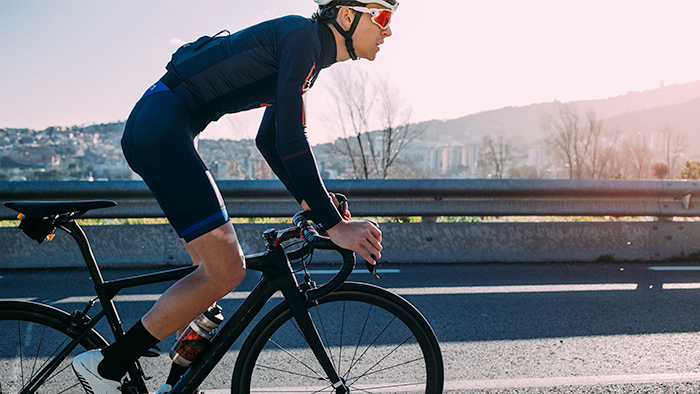You only have to watch the pro peloton at work to realize that even the best riders in the world have vastly different pedaling techniques. While we might all aspire to smooth souplesse, you can’t argue that some fairly ugly pedaling styles have made it all the way to the top (yes, we are looking at you Chris Froome).
Does your pedaling technique matter? Surprisingly the research hasn’t come up with a definitive ‘perfect’ style. Can you improve your own technique for better results? Yes, definitely.
Pedaling Efficiency
We tend to think of the action of pedaling as quite straight forward—after all, you’re simply turning a crank in a circle. But how every rider turns the cranks can vary widely depending on an individual’s anatomy; the strength and endurance of different parts of their musculature; their flexibility, and range of movement.
Dr Barney Wainwright, Senior Research Fellow at Leeds Beckett University, UK and Head of Science at the Boardman Performance Centre, UK, explains why this should matter to cyclists. “Poor pedaling can be very performance limiting. It can limit power output for climbing hills, or just traveling more quickly, and it can be very metabolically inefficient, increasing the energy cost for any given distance.” In other words, if you aren’t already working on your pedal stroke it is probably time you did.
Effective vs. Efficient
Within biomechanics and physiology research there are some important nuances between an efficient pedal stroke and an effective pedal stroke. “An effective pedal stroke is where high levels of power output can be created when needed, such as in sprints, shorter hill climbs, or track sprinting; while an ‘energy-efficient’ pedal stroke is one where for any given power output, there is minimal energy required,” says Dr. Wainwright.
“A good example of the difference between effective pedaling and energy-efficient pedaling is when you contrast out-of-the-saddle cycling with seated cycling,” Dr Wainwright expands “Most cyclists would agree that out-of-the-saddle cycling is used when you need to generate more power and be effective (e.g. sprinting or hill climbing), but this is also understood as being more energy-demanding (more inefficient) compared to seated cycling.” There is no ideal pedal stroke that works for every situation or discipline, and a given cyclist’s pedal stroke will vary with intensity, cadence, position, fatigue and also focus. A cyclist might have a very ‘good’ pedal stroke at one intensity, but a ‘poor’ stroke at another intensity.
Measuring Pedal Stroke
So how do you maximize your efficacy and efficiency while pedaling? Historically, the best bet was to get a professional analysis from a coach or bike fitter. Now, many modern platforms offering power analysis (like power meters and some smart trainers) also offer some form of pedaling efficiency analysis. You can use these tools to get a basic understanding of power differences side-to-side, find “dead zones” in your pedal stroke, and smooth out surges.
Another option is to hop on a Wattbike. The original models give you a real-time force profile for each side to show you where you are applying force throughout the pedal stroke. Poor effectiveness produces a peanut-shaped profile, while good effectiveness takes more of a sausage-shaped profile. Newer models offer a Pedalling Effectiveness Score (PES) which simplifies the original diagram to a score out of 100, with 70-80 being the optimal range.
Dr. Wainwright worked with Wattbike to develop the PES, and he emphasizes the importance of real-time data. “When learning or refining any movement pattern, having real-time and sensitive feedback is important. Can you imagine trying to hone your golf drive without being able to see the trajectory of the ball?” If you’re serious about refining your pedal stroke, it’s key to find a tool that will help you understand, in real-time, how changes to your pedal stroke affect your efficiency and effectiveness.
If you don’t have access to the gear above, one quick and simple way to understand how evenly you produce power is to head off-road. Of all the cycling disciplines, researchers have found mountain bikers produce power most consistently throughout their pedal stroke, with very little negative torque. This smooth and constant power is essential for maintaining traction on slippery surfaces or to conquer short, steep obstacles—so if you’re having problems in those areas, there’s a good chance your pedal stroke is to blame! Another option is to jump on the rollers. A ‘lumpy’ and uneven pedal stroke will quickly reveal itself as you fight for balance.
Pedal Stroke Drills
Ready to make some changes? Integrating these exercises into your warm-up or cool down is a great way to put a little bit of intentional thought into how you pedal.
Spin-ups
Select a very easy gear and pedal as fast as you can while still retaining a good position and not bouncing in the saddle. Complete 15 seconds of fast pedaling every minute for five minutes.
Single-leg Drills
Using an easy gear, alternate thirty seconds on each leg with the resting leg unclipped for five minutes. This is best done on a static trainer.
Large gear, slow cadence
Using a hard gear, pedal slowly and deliberately for thirty seconds. Rest by pedaling in an easy gear for thirty seconds, and repeat for five minutes. The idea is not to spike your heart rate, but to maintain a consistent, effective pedal stroke no matter your gearing.









